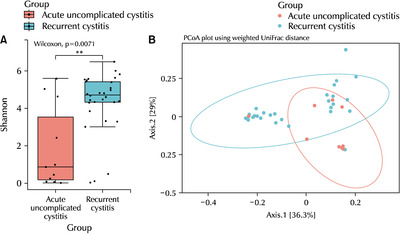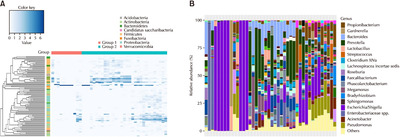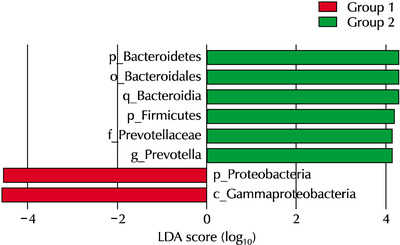Articles
- Page Path
- HOME > Urogenit Tract Infect > Volume 18(1); 2023 > Article
- Review Differences in Urine Microbiome of Acute Cystitis and Chronic Recurrent Cystitis in Women
-
Woong Bin Kim,

-
Urogenital Tract Infection 2023;18(1):1-7.
DOI: https://doi.org/10.14777/uti.2023.18.1.1
Published online: April 30, 2023
Department of Urology, Soonchunhyang University Bucheon Hospital, Soonchunhyang University College of Medicine, Bucheon, Korea
-
Correspondence to: Woong Bin Kim,
 , Department of Urology, Soonchunhyang University Bucheon Hospital, Soonchunhyang University College of Medicine, 170 Jomaru-ro, Wonmi-gu, Bucheon 14584, Korea, Tel: +82-32-621-6427, Fax: +82-32-621-5018, E-mail: woongbins@schmc.ac.kr
, Department of Urology, Soonchunhyang University Bucheon Hospital, Soonchunhyang University College of Medicine, 170 Jomaru-ro, Wonmi-gu, Bucheon 14584, Korea, Tel: +82-32-621-6427, Fax: +82-32-621-5018, E-mail: woongbins@schmc.ac.kr
Copyright © 2023, Korean Association of Urogenital Tract Infection and Inflammation. All rights reserved.
This is an open-access article distributed under the terms of the Creative Commons Attribution Non-Commercial License (http://creativecommons.org/licenses/by-nc/4.0) which permits unrestricted non-commercial use, distribution, and reproduction in any medium, provided the original work is properly cited.
- 2,353 Views
- 27 Download
Abstract
- The diagnosis of urinary tract infection (UTI) relies on urine culture tests to identify aerobic or anaerobic urinary tract pathogens. This method has limitations in identifying anaerobic bacteria, and there is uncertainty in identifying all bacteria. A new next-generation sequencing (NGS) method has gradually helped overcome these limitations, and the microorganisms present in the human urinary tract are gradually being revealed. This review introduces studies on the microbiome analyzed using NGS of urine from patients with acute cystitis and recurrent UTIs and discusses whether NGS may reveal the pathophysiology of the disease.
INTRODUCTION
MAIN BODY
CONCLUSIONS
FUNDING



| Study population | Main bacterial taxa | Sample collection | Technique used | Ref |
|---|---|---|---|---|
| Healthy men aged ∼18 yr (n=9) | Lactobacillus, Corynebacterium, Escherichia, and Streptococcus | FC urine | 16S rRNA GS | [11] |
| Healthy men (n=22) age≥18 yr, median 28 yr | Lactobacillus, Sneathia, Veillonella, Corynebacterium, Prevotella, Streptococcus, Ureaplasma, Mycoplasma, Anaerococcus, Atopobium, Aerococcus, Staphylococcus, Gemella, Enterococcus, and Finegoldia | FC urine | 16S rRNA GS | [15] |
| Healthy females aged 27–67 yr (n=8) | Lactobacillus, Prevotella, Gardnerella, Peptoniphilus, Dialister, Finegoldia, Anaerococcus, Allisonella, Streptococcus, and Staphylococcus | CC MSU | 16S rRNA GS | [12] |
|
Healthy males aged 24–50 yr (n=11) Healthy females aged 22–51 yr (n=15) |
Lactobacillus, Klebsiella, Corynebacterium, Staphylococcus, Streptococcus,Aerococcus, Gardnerella, Prevotella, Escherichia, and Enterococcus | MSU | 16S rRNA GS | [16] |
| Healthy males aged 14–17 yr (n=18) | Corynebacterium, Lactobacillus, Staphylococcus, Gardnerella, Streptococcus, Anaerococcus, Veillonella, Prevotella, and Escherichia | FC urine | 16S rRNA GS | [18] |
| Healthy women (n=12) age NA | Lactobacillus, Actinobaculum, Aerococcus, Anaerococcus, Atopobium, Burkholderia, Corynebacterium, Gardnerella, Prevotella, Ralstonia, Sneathia, Staphylococcus, Streptococcus, and Veillonella | CC MSU, SPA, and TUC | 16S rRNA GS | [13] |
|
Healthy men aged 39–86 yr (n=6) Healthy woman aged 26–90 yr (n=10) |
Male and female samples: Firmicutes; female samples: Actinobacteria, Bacteroidetes | CC MSU | 16S rRNA GS | [17] |
| Healthy women (n=24) age NA | Lactobacillus, Corynebacterium, Streptococcus, Actinomyces, Staphylococcus, Aerococcus, Gardnerella, Bifidobacterium, and Actinobaculum | TUC | 16S rRNA GS and/or EUCT | [6] |
| Healthy women aged 35–65 yr (n=58) | Lactobacillus, Gardnerella, Corynebacterium, Enterobacteriaceae, Anaerococcus, Bifidobacterium, Streptococcus, Staphylococcus, Sneathia, Peptoniphilus, Atopobium, Rhodanobacter, Trueperella, Alloscardovia, and Veillonella | TUC | 16S rRNA GS and/or EQUC | [19] |
| Healthy women aged 35–65 yr (n=60) | Lactobacillus, Gardnerella, Staphylococcus, Streptococcus, Enterococcus, Bifidobacterium, Atopobium, and Enterobacteriaceae | TUC | 16S rRNA GS and/or EQUC | [20] |
| Healthy women (n=10) | Anoxybacillus, Lactobacillus, Prevotella, Gardnerella, Arthrobacter, Escherichia, and Shigella | TUC | 16S rRNA GS | [14] |
| Study population | Taxa driving community structure/diversity | Sample collection | Technique used | Ref |
|---|---|---|---|---|
| Adult females (92) and males (29) | Some members of Enterobacteriaceae, Gardnerella, Lactobacillus, other fastidious bacteria, Candida sp., Malassezia sp. Trichomonas vaginalis; phages and HPV, Herpes sp. | Mid-stream (suspected infections) | 16S rRNA (V1-V3); and shotgun metagenomics | [28] |
| Retrospective analysis, 2000–2015); 849 urine samples, all women (aged 15–65) | Escherichia coli (80% of the cultures) and Staphylococcus saprophyticus | Mid-stream urine | Culture | [25] |
| Adult females (38) and males (16); age range: 1–94 |
P: Enterobacteriaceae (No C group) Very low diversity |
Mid-stream urine | 16S rRNA (V8), fimH typing of E. coli strains | [29] |
| Adult females, 202 cases, median age 22, range: 18–49 | P: Enterobacteriaceae growth was positive in 78% of midstream samples vs. 70% of catheter samples | Mid-stream vs. catheterized urine samples | Culture | [27] |
| 1,817 females; 300 males |
Females (Top 3): Ureaplasma urealyticum, Gardnerella vaginalis, Mycoplasma hominis Males (Top 3): Ureaplasma urealyticum, E. coli, Streptococcus spp. |
Suprapubic aspiration selected by midstream culture | Culture | [26] |
- 1. Waller TA, Pantin SAL, Yenior AL, Pujalte GGA. Urinary tract infection antibiotic resistance in the United States. Prim Care 2018;45:455-66. ArticlePubMed
- 2. Best J, Kitlowski AD, Ou D, Bedolla J. Diagnosis and management of urinary tract infections in the emergency department. Emerg Med Pract 2014;16:1-23.
- 3. Geerlings SE. Clinical presentations and epidemiology of urinary tract infections. Microbiol Spectr 2016;4:UTI-0002. ArticlePDF
- 4. Gupta K, Trautner BW. Diagnosis and management of recurrent urinary tract infections in non-pregnant women. BMJ 2013;346:f3140. ArticlePubMedPMC
- 5. Dason S, Dason JT, Kapoor A. Guidelines for the diagnosis and management of recurrent urinary tract infection in women. Can Urol Assoc J 2011;5:316-22. ArticlePubMedPMC
- 6. Hilt EE, McKinley K, Pearce MM, Rosenfeld AB, Zilliox MJ, Mueller ER, et al. Urine is not sterile: use of enhanced urine culture techniques to detect resident bacterial flora in the adult female bladder. J Clin Microbiol 2014;52:871-6. ArticlePubMedPMCPDF
- 7. Wojno KJ, Baunoch D, Luke N, Opel M, Korman H, Kelly C, et al. Multiplex PCR based urinary tract infection (UTI) analysis compared to traditional urine culture in identifying significant pathogens in symptomatic patients. Urology 2020;136:119-26. ArticlePubMed
- 8. Thomas-White K, Forster SC, Kumar N, Van Kuiken M, Putonti C, Stares MD, et al. Culturing of female bladder bacteria reveals an interconnected urogenital microbiota. Nat Commun 2018;9:1557. ArticlePubMedPMCPDF
- 9. Collins FS, Morgan M, Patrinos A. The human genome project: lessons from large-scale biology. Science 2003;300:286-90. ArticlePubMed
- 10. Turnbaugh PJ, Ley RE, Hamady M, Fraser-Liggett CM, Knight R, Gordon JI. The human microbiome project. Nature 2007;449:804-10. ArticlePubMedPMCPDF
- 11. Nelson DE, Van Der Pol B, Dong Q, Revanna KV, Fan B, Easwaran S, et al. Characteristic male urine microbiomes associate with asymptomatic sexually transmitted infection. PLoS One 2010;5:e14116. ArticlePubMedPMC
- 12. Siddiqui H, Nederbragt AJ, Lagesen K, Jeansson SL, Jakobsen KS. Assessing diversity of the female urine microbiota by high throughput sequencing of 16S rDNA amplicons. BMC Microbiol 2011;11:244. ArticlePubMedPMCPDF
- 13. Wolfe AJ, Toh E, Shibata N, Rong R, Kenton K, Fitzgerald M, et al. Evidence of uncultivated bacteria in the adult female bladder. J Clin Microbiol 2012;50:1376-83. ArticlePubMedPMCPDF
- 14. Carter MJ, Gurung P, Jones C, Rajkarnikar S, Kandasamy R, Gurung M, et al. Assessment of an antibody-in-lymphocyte supernatant assay for the etiological diagnosis of pneumococcal pneumonia in children. Front Cell Infect Microbiol 2020;9:459. ArticlePubMedPMC
- 15. Dong Q, Nelson DE, Toh E, Diao L, Gao X, Fortenberry JD, et al. The microbial communities in male first catch urine are highly similar to those in paired urethral swab specimens. PLoS One 2011;6:e19709. ArticlePubMedPMC
- 16. Fouts DE, Pieper R, Szpakowski S, Pohl H, Knoblach S, Suh MJ, et al. Integrated next-generation sequencing of 16S rDNA and metaproteomics differentiate the healthy urine microbiome from asymptomatic bacteriuria in neuropathic bladder associated with spinal cord injury. J Transl Med 2012;10:174. ArticlePubMedPMCPDF
- 17. Lewis DA, Brown R, Williams J, White P, Jacobson SK, Marchesi JR, et al. The human urinary microbiome; bacterial DNA in voided urine of asymptomatic adults. Front Cell Infect Microbiol 2013;3:41. ArticlePubMedPMC
- 18. Nelson DE, Dong Q, Toh E, Fan B, Katz BP, et al. Van der Pol B. Bacterial communities of the coronal sulcus and distal urethra of adolescent males. PLoS One 2012;7:e36298. ArticlePubMedPMC
- 19. Pearce MM, Hilt EE, Rosenfeld AB, Zilliox MJ, Thomas-White K, Fok C, et al. The female urinary microbiome: a comparison of women with and without urgency urinary incontinence. mBio 2014;5:e01283-14. ArticlePubMedPMCPDF
- 20. Thomas-White KJ, Hilt EE, Fok C, Pearce MM, Mueller ER, Kliethermes S, et al. Incontinence medication response relates to the female urinary microbiota. Int Urogynecol J 2016;27:723-33. ArticlePubMedPDF
- 21. Pometto A, Shetty K, Paliyath G, Levin RE. Food biotechnology. CRC Press; Boca Raton (FL):
- 22. Foxman B. Urinary tract infection syndromes: occurrence, recurrence, bacteriology, risk factors, and disease burden. Infect Dis Clin North Am 2014;28:1-13. PubMed
- 23. Flores-Mireles AL, Walker JN, Caparon M, Hultgren SJ. Urinary tract infections: epidemiology, mechanisms of infection and treatment options. Nat Rev Microbiol 2015;13:269-84. ArticlePubMedPMCPDF
- 24. Foxman B. The epidemiology of urinary tract infection. Nat Rev Urol 2010;7:653-60. ArticlePubMedPDF
- 25. Bollestad M, Vik I, Grude N, Blix HS, Brekke H, Lindbaek M. Bacteriology in uncomplicated urinary tract infections in Norwegian general practice from 2001-2015. BJGP Open 2017;1:bjgpopen17X101145. ArticlePubMedPMC
- 26. Fairley KF, Birch DF. Detection of bladder bacteriuria in patients with acute urinary symptoms. J Infect Dis 1989;159:226-31. ArticlePubMed
- 27. Hooton TM, Roberts PL, Cox ME, Stapleton AE. Voided midstream urine culture and acute cystitis in premenopausal women. N Engl J Med 2013;369:1883-91. ArticlePubMedPMC
- 28. Moustafa A, Li W, Singh H, Moncera KJ, Torralba MG, Yu Y, et al. Microbial metagenome of urinary tract infection. Sci Rep 2018;8:4333. ArticlePubMedPMCPDF
- 29. Willner D, Low S, Steen JA, George N, Nimmo GR, Schembri MA, et al. Single clinical isolates from acute uncomplicated urinary tract infections are representative of dominant in situ populations. mBio 2014;5:e01064-13. ArticlePubMedPMCPDF
- 30. Yoo JJ, Shin HB, Song JS, Kim M, Yun J, Kim Z, et al. Urinary microbiome characteristics in female patients with acute uncomplicated cystitis and recurrent cystitis. J Clin Med 2021;10:1097. ArticlePubMedPMC
- 31. McDonald M, Kameh D, Johnson ME, Johansen TEB, Albala D, Mouraviev V. A head-to-head comparative phase II study of standard urine culture and sensitivity versus DNA next-generation sequencing testing for urinary tract infections. Rev Urol 2017;19:213-20. PubMedPMC
- 32. Karakan T. Akgül T. The role of probiotics in women with recurrent urinary tract infections. Turk J Urol 2018;44:377-83. ArticlePubMedPMC
- 33. Toh SL, Boswell-Ruys CL, Lee BSB, Simpson JM, Clezy KR. Probiotics for preventing urinary tract infection in people with neuropathic bladder. Cochrane Database Syst Rev 2017;9:CD010723. ArticlePubMed
- 34. Biehl LM, Cruz Aguilar R, Farowski F, Hahn W, Nowag A, Wisplinghoff H, et al. Fecal microbiota transplantation in a kidney transplant recipient with recurrent urinary tract infection. Infection 2018;46:871-4. ArticlePubMedPDF
- 35. Mokoena MP. Lactic acid bacteria and their bacteriocins: classi-fication, biosynthesis and applications against uropathogens: a mini-review. Molecules 2017;22:1255. ArticlePubMedPMC
REFERENCES
Figure & Data
REFERENCES
Citations




Fig. 1
Fig. 2
Fig. 3
Studies on healthy human urine microbiome
| Study population | Main bacterial taxa | Sample collection | Technique used | Ref |
|---|---|---|---|---|
| Healthy men aged ∼18 yr (n=9) | Lactobacillus, Corynebacterium, Escherichia, and Streptococcus | FC urine | 16S rRNA GS | [ |
| Healthy men (n=22) age≥18 yr, median 28 yr | Lactobacillus, Sneathia, Veillonella, Corynebacterium, Prevotella, Streptococcus, Ureaplasma, Mycoplasma, Anaerococcus, Atopobium, Aerococcus, Staphylococcus, Gemella, Enterococcus, and Finegoldia | FC urine | 16S rRNA GS | [ |
| Healthy females aged 27–67 yr (n=8) | Lactobacillus, Prevotella, Gardnerella, Peptoniphilus, Dialister, Finegoldia, Anaerococcus, Allisonella, Streptococcus, and Staphylococcus | CC MSU | 16S rRNA GS | [ |
| Healthy males aged 24–50 yr (n=11) Healthy females aged 22–51 yr (n=15) |
Lactobacillus, Klebsiella, Corynebacterium, Staphylococcus, Streptococcus,Aerococcus, Gardnerella, Prevotella, Escherichia, and Enterococcus | MSU | 16S rRNA GS | [ |
| Healthy males aged 14–17 yr (n=18) | Corynebacterium, Lactobacillus, Staphylococcus, Gardnerella, Streptococcus, Anaerococcus, Veillonella, Prevotella, and Escherichia | FC urine | 16S rRNA GS | [ |
| Healthy women (n=12) age NA | Lactobacillus, Actinobaculum, Aerococcus, Anaerococcus, Atopobium, Burkholderia, Corynebacterium, Gardnerella, Prevotella, Ralstonia, Sneathia, Staphylococcus, Streptococcus, and Veillonella | CC MSU, SPA, and TUC | 16S rRNA GS | [ |
| Healthy men aged 39–86 yr (n=6) Healthy woman aged 26–90 yr (n=10) |
Male and female samples: Firmicutes; female samples: Actinobacteria, Bacteroidetes | CC MSU | 16S rRNA GS | [ |
| Healthy women (n=24) age NA | Lactobacillus, Corynebacterium, Streptococcus, Actinomyces, Staphylococcus, Aerococcus, Gardnerella, Bifidobacterium, and Actinobaculum | TUC | 16S rRNA GS and/or EUCT | [ |
| Healthy women aged 35–65 yr (n=58) | Lactobacillus, Gardnerella, Corynebacterium, Enterobacteriaceae, Anaerococcus, Bifidobacterium, Streptococcus, Staphylococcus, Sneathia, Peptoniphilus, Atopobium, Rhodanobacter, Trueperella, Alloscardovia, and Veillonella | TUC | 16S rRNA GS and/or EQUC | [ |
| Healthy women aged 35–65 yr (n=60) | Lactobacillus, Gardnerella, Staphylococcus, Streptococcus, Enterococcus, Bifidobacterium, Atopobium, and Enterobacteriaceae | TUC | 16S rRNA GS and/or EQUC | [ |
| Healthy women (n=10) | Anoxybacillus, Lactobacillus, Prevotella, Gardnerella, Arthrobacter, Escherichia, and Shigella | TUC | 16S rRNA GS | [ |
FC: first catch, CC: clean catch, MSU: mid stream urine, SPA: suprapubic aspirate, TUC: transurethral catheter, GS: gene sequencing, EUCT: enhanced urine culture technique, EQUC: expanded quantitative urine culture.
Studies on urine microbiome of patients with acute uncomplicated cystitis
| Study population | Taxa driving community structure/diversity | Sample collection | Technique used | Ref |
|---|---|---|---|---|
| Adult females (92) and males (29) | Some members of Enterobacteriaceae, Gardnerella, Lactobacillus, other fastidious bacteria, Candida sp., Malassezia sp. Trichomonas vaginalis; phages and HPV, Herpes sp. | Mid-stream (suspected infections) | 16S rRNA (V1-V3); and shotgun metagenomics | [ |
| Retrospective analysis, 2000–2015); 849 urine samples, all women (aged 15–65) | Escherichia coli (80% of the cultures) and Staphylococcus saprophyticus | Mid-stream urine | Culture | [ |
| Adult females (38) and males (16); age range: 1–94 | P: Enterobacteriaceae (No C group) Very low diversity |
Mid-stream urine | 16S rRNA (V8), fimH typing of E. coli strains | [ |
| Adult females, 202 cases, median age 22, range: 18–49 | P: Enterobacteriaceae growth was positive in 78% of midstream samples vs. 70% of catheter samples | Mid-stream vs. catheterized urine samples | Culture | [ |
| 1,817 females; 300 males | Females (Top 3): Ureaplasma urealyticum, Gardnerella vaginalis, Mycoplasma hominis Males (Top 3): Ureaplasma urealyticum, E. coli, Streptococcus spp. |
Suprapubic aspiration selected by midstream culture | Culture | [ |
Urine microbiome strains identified through next-generation sequencing [
| Acute uncomplicated cystitis | Recurrent urinary tract infection |
|---|---|
| Escherichia/Shigella | Escherichia/Shigella spp. |
| Pseudomonas spp. | Pseudomonas spp. |
| Bradyrhizobium spp. | Acinetobacter spp. |
| Acinetobacter spp. | Sphingomonas spp. |
| Enterobacteriaceae | Bradyrhizobium spp. |
| Staphylococcus spp. | |
| Streptococcus spp. | |
| Actinobaculum spp. | |
| Rothia spp. |
FC: first catch, CC: clean catch, MSU: mid stream urine, SPA: suprapubic aspirate, TUC: transurethral catheter, GS: gene sequencing, EUCT: enhanced urine culture technique, EQUC: expanded quantitative urine culture.

 KAUTII
KAUTII
 ePub Link
ePub Link Cite
Cite

